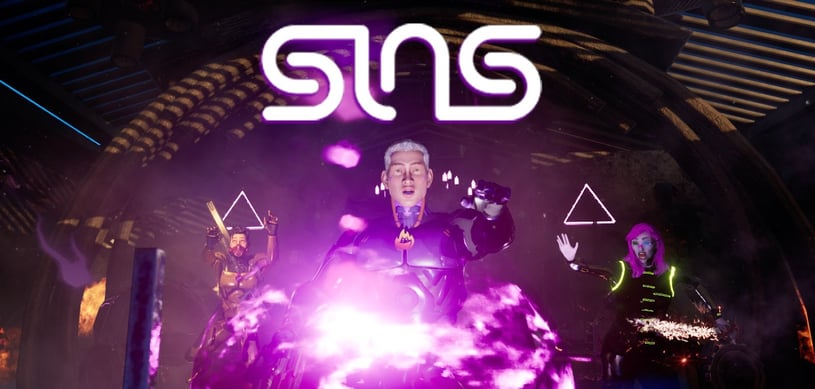 A recurring discussion point within metaverse circles is how we enter a new stage of active consumerization. Audiences will no longer play a passive role in watching a television show or film but instead, have the ability to be an active participant within a story world. In this regard, gaming has led the way, with platforms such as Roblox allowing players to customize their character, interact with friends, and be the overall driving force for what takes place within their story.
A recurring discussion point within metaverse circles is how we enter a new stage of active consumerization. Audiences will no longer play a passive role in watching a television show or film but instead, have the ability to be an active participant within a story world. In this regard, gaming has led the way, with platforms such as Roblox allowing players to customize their character, interact with friends, and be the overall driving force for what takes place within their story.
Sombra, founded by Brendan O’Neil of visual effects studio Bonfire, looks to introduce this sort of audience interactivity with the release of SINS. The cross-media project ventures into the video game and television world and aims to give audiences the chance to assert their influence on the series’ narrative in a way that is only possible through Web3 technologies.
SINS was an immediate success, selling out its original collection soon after its initial release, with the second batch due to be released in August. Shortly before the first NFT collection went live on May 4th, we sat down with Brendan O’Neil to discuss his SINS project, his origins in Web3 and how the ability to bring unique movements into Metaverse platforms with ‘motion-print’ will be key in the development of Web3.
Would you mind starting by telling us a bit about the beginnings of Sombra and when you first started working within the web3 world?
Sombra is a sister company to my pre-existing visual effects studio Bonfire, which lives out of New York City.
I’ve always been interested in the evolution of virtual production, being able to disseminate information to people about the latest technology trends, which led me to join an ‘Unreal Engine virtual production’ Facebook group, where I met Demian Gordon. Demian has been involved with motion capture for a long time for many top films and productions and has worked at Dreamworks, and other places. Together, we wanted to explore the more experimental world of NFTs and see what we could do together.
At Bonfire, we’ve been doing high-level VFX work for a long time, but we also started experimenting with both motion-capture and NFT technologies. We produced a campaign for Subway sandwiches with the NFL player Marshawn Lynch, where he would play a digital character, and Demian was the one who suggested we use Xsens for that. And on the side, we were creating NFTs and seeing what we could do there. Sombra was a natural progression from the type of work we were already doing, and it allowed us to focus on Web3, which is something that we were really interested in.

How does Bonfire’s VFX experience inform your NFT creations and storytelling?
Going from VFX work to creating NFTs was a natural progression for us. We were running a visual effects studio that's been doing top-level work since 2015, and because of this, we built up relationships with a bunch of different brands and partners who became very interested in NFTs. And so for us, not only did we see the opportunity for us to transition in for VFX, but we also wanted to uplift our clients moving forward.
“...there are some subtleties to Web3 that you have to give consideration to, but a lot of the same disciplines and rules apply”
And from a VFX perspective, the basic stuff that we do is easily transferred into Web3 - it's the same content. We're just now making it for a different medium. Obviously, there are some subtleties to Web3 that you have to consider, but many of the same disciplines and rules apply. What especially helped was that we come from more of a commercial-based background, which is very fast-paced.
It's been a really easy transition for us, technically and artistically. And it's also been a really easy transition in terms of having these conversations with either brands and clients about Web3 and the metaverse, but also with artists themselves. I think it's really beneficial because there are a lot of stigmas behind crypto and NFT. It's definitely helped us open the doors on many different levels to people that either weren't exposed to, were potentially disbelievers, or just weren't interested in general. And I think that’s really rewarding.
Could you tell us a bit about the SINS project and how it came about?
For Bonfire, and then Sombra, as a visual effects-based studio, there was always this plan to create our own IP, which would be the focal point of our creative endeavors, resulting in SINS.
Being a huge fan of television, I found it fascinating when a show like Game of Thrones would spark huge levels of excitement across social media. And I think it really is an interesting one because it allows people to come together as a community around a product, and that's something that builds that brand. And if it’s possible to be a part of this TV show via owning an NFT that represents a real character and helps dictate what that character will do, then it’s even more amazing and opens up a level of creative engagement that was never possible before. So this idea of audience interactivity was very inspiring for us when we first started developing SINS.
“The choices that a player makes in this game will be reflected in our narrative series.”
SINS is being released in phases, the first being a 2D NFT collection, which launched May 4th, and those that acquired an NFT as part of that release become part of our broader ecosystem. Once they’re in that ecosystem, they’ll have the opportunity to upgrade their avatar into a 3D, game-ready version. Then later down the line, we’ll release our monthly cinematic steaming series and an open-world video game. SINS NFT owners will see their characters become part of the TV series show, and the collective community will participate in a monthly vote on what should happen next, and we then write the episodes according to those results. The story is also influenced by our open-world game, which is based on a ‘good faith’ system, and the choices that a player makes in this game will be reflected in our narrative series.
Check out the latest video:
What are the challenges of building a community for an NFT project, and how important is it to maintain these audience relationships?
It's hard for sure. It's very taxing emotionally, and it can be mentally exhausting. With so many people having different demands and expectations from you as a creator, I can say that I can’t recommend it unless you take it super seriously. We've gone to great lengths to give our community transparency and honesty and to try to deliver what we discussed.
Building a community requires love, passion for what you're doing, and a true believer in the project. And not only that but genuine care for the people who are interested in your work and going the extra mile to ensure they are getting the most out of our product and services.
“we’re looking … to give NFT owners the chance to use an Xsens suit to bring their own movements to their SINS character.”
Something we’re looking to do in the future is to give NFT owners the chance to use an Xsens suit to bring their own movements to their SINS character. And whether this is through Zoom, or going out to meet our community in person, we’ll be able to walk them through the technicalities of Xsens and be a general resource for them.
In the past, we’ve spoken about ‘Motion Print’, the idea that people will be able to use their motion-captured movements in metaverse platforms - could you tell us a bit about your thoughts on this?
Motion Print is definitely an idea that has resonated with me. It reminds me of WWE, where each wrestler has their unique entrance that defines them as a character to the audience, making them instantly recognizable. I think this shows that there's so much personality to be told through motion and so much individuality that can't be replicated either by another individual.
Read more about Sombra here.
Experience Xsens MVN Animate
Sombra uses Xsens MVN Animate as their solution. It enables you to mocap anywhere, at any time. Want to know what we can do for you? Get in touch!
